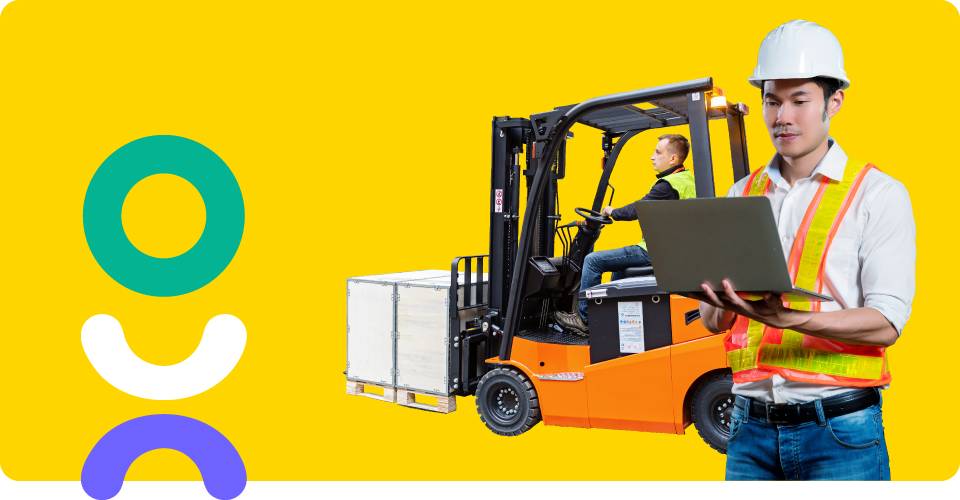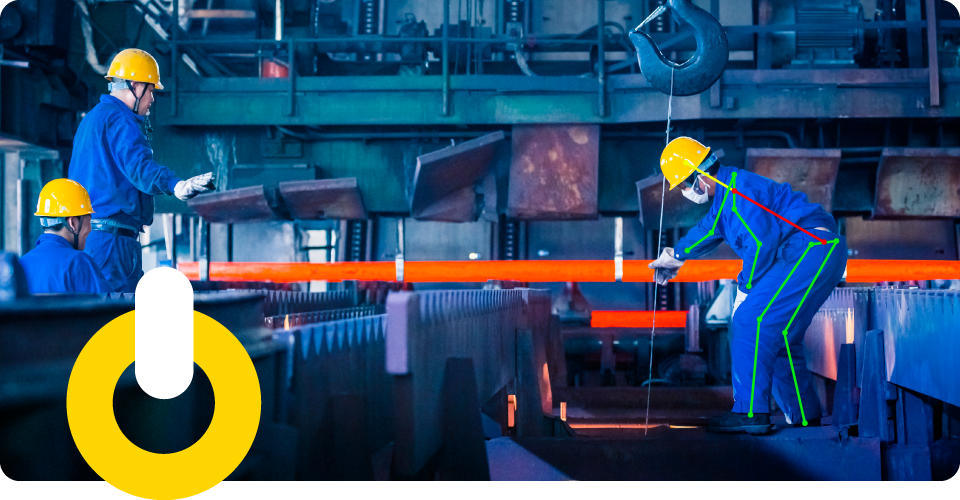Ergonomics and the Future of Occupational Health and Safety


- 22.12.2023
- Ergonomics, Health & Safety, Workforce Productivity

In the 19th century, the average factory worker handled valves, levers, and buttons to control machines, lifted heavy loads, and operated noisy machines at high temperatures and in low light. Today’s factory workers increasingly integrate robots/cobots, exoskeletons, computers and lift-assist devices into their toolkits. Efficiently managing these evolving workspaces requires placing greater importance on the role that ergonomics plays in improving both safety and productivity.
In this blog, business owners, EHS&Q managers and planners, and employees will gain an understanding of the ever-growing importance of ergonomics to workplace health and safety in industrial settings. In addition, you will learn about existing and future tools for ergonomics management.
The Importance of Ergonomics to OHS
Ergonomics is the study of the relationship between machines, equipment, conditions, and humans. In work settings, ergonomics facilitates designing workplaces to match people’s capabilities so that employee well-being and business performance are improved. Ergonomics also applies to the design of the devices, machines, and spaces we interact with every day, in and outside our jobs.
The importance of ergonomics has only seemed to grow with the introduction of new technologies like computers, power tools, robots, and more. While many of these technologies have improved workplace productivity and reduced the need for physical labor, the way they are used can also introduce new health problems like eyestrain, carpal tunnel syndrome, and backache. These problems can be avoided by implementing good workspace design and practices. The role of ergonomics is only becoming more important in today’s working environment.
While ergonomics appears to be everywhere in today’s businesses, this was not always the case. The origin of ergonomics as we know it traces back to the late 19th century when production was largely dependent on manual labor and ergonomic concepts started being developed to improve worker productivity. Simple yet significant advances were accomplished during this time. For instance, by assigning standardized tools for specific tasks, like shovels for coal, and performing time-motion observations, jobs were made more efficient and less fatiguing. This led to a significant reduction in the number of motion-related injuries and an increase in productivity in construction, mining, and production factories.
During World War II, analysis of human-machine interactions gained significant attention as the success and safety of military equipment could be compromised by poor or confusing design. Concepts such as fitting the machine to the size of the soldier and creating understandable controls became the norm. After World War II, these concepts were more widely applied to include the safety and comfort of workers, which served to reduce injuries and boost productivity. Since then, the evolution of ergonomics has been as fast-paced as that of technology, and many industry professions are specifically dedicated to addressing ergonomic issues.
After all, there can be severe consequences for ignoring ergonomics. One of the most recognizable consequences of poor ergonomic practices is a group of painful disorders of the muscles, nerves, tendons, ligaments, joints, cartilage, or spinal discs, collectively referred to as musculoskeletal disorders (MSDs). Globally, MSDs are the leading contributor to disability worldwide, with low back pain being the main reason for a premature exit from the workforce. In the United States, Canada, and Europe, MSDs account for 31%, 50%, and 39% of all occupational injuries and illnesses respectively.
The economic and social consequences of MSDs are astonishing. In 2007, the direct and indirect costs of MSDs were $1.5 and $1.1 billion respectively in the United States alone. Moreover, tragically, MSDs have been identified as a key causal factor in opioid-related overdose deaths globally. A 2012 study reported that 57% of opioid-related overdose deaths occurred after a work injury, with 13% of deaths by overdose being preceded by a work injury within the past 3 years. There is also a clear link between opioid use and industries like construction, which have physically demanding working conditions and higher rates of MSD injuries. Taken together, the importance and urgency of reducing MSD-type injuries cannot be understated.
This can be accomplished in part through the widespread adoption of good ergonomic practices by businesses, which translates to preventing or reducing ergonomic hazards that could lead to injuries. The most common of these ergonomic hazards include:
- Frequent lifting, pushing, pulling, and use of excessive force
- Poor posture
- Repetitive unnatural movements
- Vibrations
- Improperly adjusted workstations and chairs
- Extreme low and high temperatures and humidity
- Noise
These hazards are often a result of the way workflows and spaces are designed, which ultimately influences how employees interact with their workspace and equipment. Managing how employees interact with ergonomic hazards in their environment is crucial, so managers and EHS professionals need the right tools to evaluate ergonomic risk.

Common Ergonomic Assessment Methods
Ergonomic assessment tools are regularly used for identifying and quantifying ergonomic risks to make changes in the tasks and environment conditions measurable. Conducting an ergonomic assessment is a simple process in which an EHS&Q practitioner assesses the work conditions and environment to evaluate how personnel interacts with them.
The first step required to conduct an ergonomic assessment is selecting the best method for the situation. These methods are divided into two categories:
- Posture-based ergonomic evaluation methods use points-based systems to rank areas of concern.
- Biomechanical-based ergonomic evaluation methods are based on evaluating tasks that involve moving a load from one place to another.
Four common ergonomic assessment methods are covered in this article. The first two methods described, RULA and REBA, are examples of the most common posture-based ergonomic assessment methods.
Rapid upper limb assessment (RULA)
This method was developed to quickly evaluate the exposure to ergonomic risk factors associated with upper extremity MSDs. This is done by evaluating postural load requirements for performing a particular activity, including body posture, force exertion, and activity frequency. The requirements are recorded in a single-page sheet and are assigned scores for each body region: arm, wrist, neck, and trunk. Once data is collected, it is used to compile a single MSD risk score.
While RULA easily delivers ergonomic assessments, it comes with some clear limitations. For instance, this method does not take into account the duration of a task or recovery intervals. In addition, RULA focuses on the worst-case posture at any given time which may not be fully representative of the tasks performed.
Rapid entire body assessment (REBA)
This method is similar to RULA in that it uses a single-page sheet to quickly record and evaluate specific body postures during tasks. The outcome of this assessment is a single MSD risk factor score. REBA shares similar benefits and limitations to RULA, but instead of being focused on the upper body alone, REBA takes into consideration the whole body, including the upper arm, forearm, wrists, neck, trunk, and legs. REBA can also account for handles and grips.
For both the RULA and REBA methods, ergonomics practitioners should keep in mind the following questions during assessments to get the most value out of the results:
- Do the evaluated postures apply to workers of all heights?
- Are the evaluated postures transient or permanent?
- How often do these postures occur?
- What level of strength do these postures require?
- Would training or changes in the activity help in eliminating the posture?
Addressing the items in this list will add useful information to the MSD score and is helpful for developing strategies to decrease ergonomic risk.
While RULA and REBA are focused primarily on addressing concerns with posture, the two methods described next, the Snook tables and the NIOSH lifting equation, are common biomechanical-based ergonomic assessment methods.
The Snook tables
The American insurance company, Liberty Mutual, established a set of tables to determine whether lifting something was suitable or unsuitable. Given that they provide statistical information about various capabilities for different population groups, these tables can be used for identifying what portion of the population should be able to safely conduct a particular labor task. This considers variables like the vertical height of the item, its weight, hand distance, hand height before and after the object has been lifted, frequency of tasks, and the distance it should be pulled, pushed, or carried.
While easier to utilize, the Snook tables are generally not as insightful as the NIOSH lifting equation.
NIOSH lifting equation
Developed from work at the National Institute of Occupational Safety and Health (NIOSH) in the USA, this method uses an equation to determine whether lifting a load is acceptable or not. The equation makes it possible to calculate the recommended weight limit that can be handled by the majority of healthy people during the working day. The calculation considers:
- The horizontal distance of the load from the worker.
- The vertical height and displacement during the lift.
- The angle of symmetry between the mid-plane of the body and the direction of the lift.
- Frequency and duration of lifting.
- Coupling between the worker’s hand and the object.
While useful and popular among EHS&Q professionals, there are some situations where the NIOSH equation does not apply:
- When lifting with one hand.
- When lifting occurs for longer than an 8-hour shift.
- When kneeling or sitting.
- In cramped or restricted spaces.
- When lifting unbalanced objects like containers with liquids and half-full boxes.
- When using a wheelbarrow or shovel.
- For quick lifting (high acceleration).
- On slippery floors.
- In unfavorable environmental conditions, such as at high humidity levels, or at temperatures outside of the 19°C to 26°C range.
Summary of modern ergonomic analysis methods
As mentioned above, the RULA and REBA methods are based on postures while the Snook tables and the NIOSH lifting equation are based on biomechanics or movement. While biomechanical methods take longer to carry out and provide more numerical results than posture-based analysis methods, new tools like mobile apps and AI-powered video analysis are making the collection and analysis of data easier and faster for both types. It is advised to keep in mind that each assessment tool was designed considering a specific set of risk factors, like unnatural postures or repetitive movements. The relevance of these risk factors varies from one task to another, so it is up to EHS&Q practitioners to identify the suitability of assessment tools for each task. Best practices for completing ergonomic risk assessments generally include using a balance of different assessment tools depending on the tasks at hand. Overall, these assessment methods are part of a wide range of tools for managing ergonomics in the workplace. With changes in technology and work practices, these tools will continue adapting to future trends and needs in the workplace.
The Future of Ergonomics
Modern workspaces and the nature of the work we do are constantly changing as a result of a number of factors. New, cutting-edge technologies, like artificial intelligence (AI), collaborative robots, and the internet of things (IoT), are changing the tasks that workers need to perform. Similarly, massive, uncontrollable events, like the COVID-19 pandemic, can exert lasting influence over what our workspaces look like.
These factors can have major implications on workplace ergonomics and introduce new challenges. However, innovative managerial and technology tools have the potential to improve ergonomic performance amidst an evolving work environment. These are some of the ways that modern ergonomics is changing.
Industry 4.0
In the last couple of decades, there has been a movement toward the integration of machines, people, IoT, and big data into digitally connected production systems. This increase in connectivity is at the center of the Fourth Industrial Revolution, also known as Industry 4.0, where machines and processes are becoming part of an intelligent network.
The technology, ideas, and infrastructure developed in Industry 4.0 bring many opportunities for ergonomics. For instance, complex networks of wearables devices used by humans and sensors in machines can process live information of the movements, posture, vibrations, loads, and environmental conditions that workers are exposed to. With these advancements, organizations can constantly collect and process large volumes of data to deliver live, personalized ergonomic assessments and analyses, adding to the value of existing assessment tools. In addition, new levels of connectivity will allow the sharing of data within and across departments. With this information, workers can be notified in real-time on the production floor, of ergonomic hazards and unsafe working conditions so that actions can be taken to eliminate or reduce the risks of fatigue or injury.
New Technologies for Ergonomics
Overall, innovative new tools and methods for managing workplace ergonomics are constantly in development. Depending on the type of work environment an employee is exposed to, they could be exposed to any of the following new ergonomic technologies in their workspace.
On the factory floor, new technologies and equipment are improving ergonomics:
● Collaborative robots, or cobots, are machines that work side-by-side with employees to perform a given manufacturing task. The use of cobots is expected to reduce the workload and fatigue of operators. In addition, the multiple sensors and actuators installed in cobots allow them to know and predict the movements of workers around them. These sensors can provide data to develop AI-powered, real-time models of the motion and position of the employee’s bodies. Ergonomic indicators can be defined to determine optimal trajectories and workloads for humans and machines to perform tasks together safely.
● Exoskeletons are mainly used to provide either additional support or strength to the human body and are called passive or active exoskeletons respectively. They can assist operators with repetitive overhead operations in factory environments. This assistance reduces physical stress on a worker's musculoskeletal system, though there is some concern that this comes at the cost of increased cognitive stress for the exoskeleton’s operator.
● Virtual reality (VR) presents a fully digitized version of the world for users to navigate and interact. In augmented reality (AR), digital information is superimposed on real images. By using drones and robots equipped with cameras to get into small or dangerous spaces, VR and AR can reduce or eliminate the need for workers to physically enter and operate in these congested, hazardous spaces. In addition, these technologies allow projecting a realistic and immersive point of view to multiple screens, which helps promote collaboration in real-time without needing to expose multiple workers to potentially inhospitable conditions.
● The development of AI-powered video analysis tools, or computer vision, is a key component to the future of ergonomics in the workplace. A network of cameras and smart assessment tools, paired with additional information from machine and environmental sensors, can record, analyze, and report risk assessments in a timely and accurate fashion. These systems can detect poor posture, exposure to harmful vibrations, repetitive movements, overexertion when handling loads, inappropriate use of tools, and more. In addition, the videos recorded and the models generated from them can be used in the future to implement corrective measures, calibrate new AI tools, validate EHS&Q management systems, and train personnel.
While the interactions between machines and humans continue to be relevant in everyday life, technology and changes in work culture will continue providing opportunities for improving the well-being of employees, especially as it pertains to ergonomics.
In Summary
The nature of workplace ergonomics has changed drastically in recent times, and the pressures on organizations and EHS&Q departments to ensure worker safety are higher than ever. In industrial settings, business leaders and EHS&Q managers can count on ergonomic assessment tools and advanced technologies to ensure workers are able to perform their jobs safely.
The challenge for EHS&Q professionals is in evaluating the suitability of the various ergonomic tools available and developing a customized solution for the workers they are supporting. Strategic planning, adaptability, and applying the right tools are essential for managing the dynamic ergonomic needs of workers in the future.
Knowella AI Inc. offers an industry-leading digital solution to managing EHS&Q. We provide workers, supervisors, EHS&Q professionals, and top-level management the tools they need to improve workplace safety. We use AI-powered data analysis to optimize your approach to EHS&Q, resulting in lower operating costs and quantifiable improvements to your safety performance.
- 22.12.2023

Businesses can obtain certification in a standard for occupational health and safety management in order to prevent and reduce onsite work accidents…

OSHA’s record keeping rules require employers to maintain accurate and detailed records of workplace injuries and illnesses.

Explore AI’s role in revolutionizing workplace safety through ergonomics. Learn how it’s shaping the future of safer work environments.